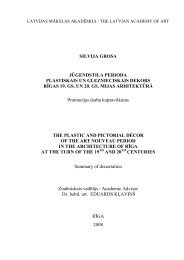Institute of Art History of the Latvian Academy of Art Anna Ancāne ...
Institute of Art History of the Latvian Academy of Art Anna Ancāne ...
Institute of Art History of the Latvian Academy of Art Anna Ancāne ...
Create successful ePaper yourself
Turn your PDF publications into a flip-book with our unique Google optimized e-Paper software.
Street, etc. One <strong>of</strong> <strong>the</strong> most splendid examples has survived in <strong>the</strong> inner<br />
yard <strong>of</strong> <strong>the</strong> former Jürgen Helms’ House (<strong>the</strong> present Mentzendorff’s<br />
House) at 18 Grēcinieku Street (1695). The single portal providing an<br />
insight into <strong>the</strong> transitional period from Mannerist tradition to classicising<br />
Baroque is <strong>the</strong> burgomaster Melchior von Dreiling’s House portal at 5<br />
Mazā Jauniela (before 1661). The formal language is similar to <strong>the</strong> plastic<br />
solutions <strong>of</strong> portals in Stockholm about 1640 – 1650, <strong>the</strong> compositional<br />
scheme – to Philibert de L’Orme’s and Serlio’s samples.<br />
Many variations belong to <strong>the</strong> group <strong>of</strong> ornamental portals in which a<br />
reduced version <strong>of</strong> <strong>the</strong> decorative arch is used. Such examples are found<br />
in <strong>the</strong> entrance finish <strong>of</strong> storehouses. Portals were crowned with exotic<br />
fauna, floral and flower motifs, symbolic cornucopia that were both <strong>the</strong><br />
owner’s signs and address indications (Camel’s and Elephant’s<br />
Storehouses).<br />
In <strong>the</strong> 1680s and 1690s architectonic-sculptural portals reached top<br />
popularity. They largely had tectonic compositions based on <strong>the</strong> elements<br />
<strong>of</strong> classical orders: pilasters supported an entablature with various décor,<br />
both ornamental and sculptural. Open pediments with straight or curved<br />
slopes were very common (Dannenstern’s House portals, 26 Mārstaļu<br />
Street). In some cases pure tectonics predominates (at 26 Jauniela, <strong>the</strong><br />
1690s, at 18/20 Smilšu Street, 12 and 14 Kaļķu Street (present 20 Kaļķu<br />
Street)). The portal <strong>of</strong> <strong>the</strong> Large Guild’s renovated façade was created<br />
according to classical examples, with Doric pilasters and a sculptural<br />
composition on <strong>the</strong> top. The loosely defined “tectonic” group <strong>of</strong> Riga’s<br />
portals <strong>of</strong> <strong>the</strong> 2 nd half <strong>of</strong> <strong>the</strong> 17 th century are close to <strong>the</strong> finish <strong>of</strong> rich<br />
burghers’ houses in Hamburg, especially concerning <strong>the</strong> proportions <strong>of</strong><br />
architectonic elements.<br />
V.4. Window decoration<br />
In <strong>the</strong> 2 nd half <strong>of</strong> <strong>the</strong> 17 th century not just <strong>the</strong> compositional principle <strong>of</strong><br />
Riga’s dwelling and public houses changed but <strong>the</strong> number and form <strong>of</strong><br />
windows as well: <strong>the</strong>y grew wider, nearing a square. Windows <strong>of</strong> <strong>the</strong><br />
entresol floor used to have a horizontal stretch. Round or oval, oculustype<br />
small windows in <strong>the</strong> upper part <strong>of</strong> gables also entered <strong>the</strong><br />
architecture <strong>of</strong> Baroque Riga. Classical ear-shaped window frames got<br />
very popular; <strong>the</strong>y were stone-carved and plaster-moulded as well as<br />
painted (at 18 Grēcinieku Street and 16 Jāņa Street). Elaborated window<br />
frames have survived just in <strong>the</strong> windows <strong>of</strong> Dannenstern’s House but <strong>the</strong><br />
building at 3 Grēcinieku Street had square-shaped windows with earshaped<br />
frames and diamond-pointed keystones. This is <strong>the</strong> only known<br />
example in Riga where <strong>the</strong> dropped keystones typical <strong>of</strong> Baroque<br />
windows are used. Small pediments over windows are quite rarely found<br />
(on Michael von Strokirch’s palace). Baroque houses tended to have<br />
window finish <strong>of</strong> rusticated blocks (at 26 Jauniela). Average house finish<br />
25












